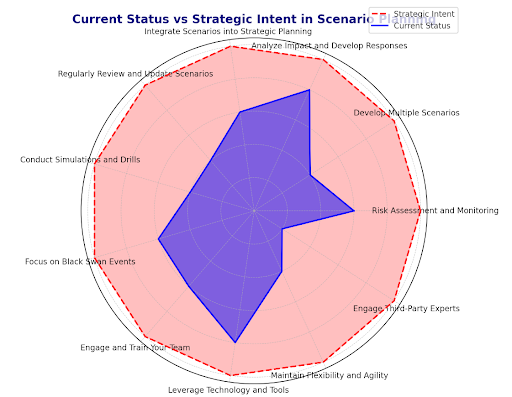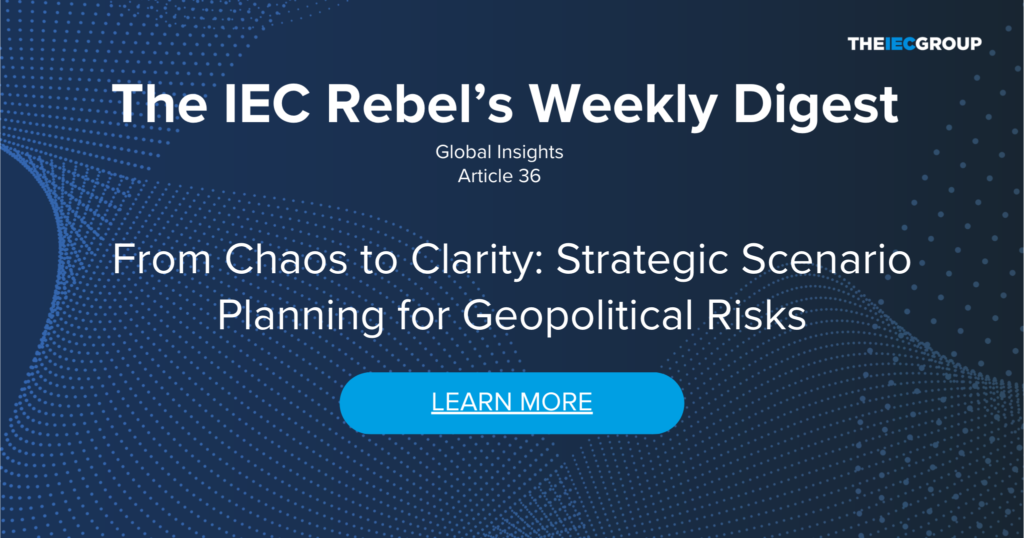From Chaos to Clarity: Strategic Scenario Planning for Geopolitical Risks
 In our previous IEC Rebel’s Digest Article #35, titled “Adapting to a Changing World: Business Strategies for Geopolitical Uncertainty,” we emphasized the importance of scenario planning. Our research reveals that while most companies acknowledge the value of scenario planning, fewer than 10% actually implement it for strategic purposes. Even fewer organizations incorporate external parties to rigorously challenge their assumptions and consider unexpected scenarios.
In our previous IEC Rebel’s Digest Article #35, titled “Adapting to a Changing World: Business Strategies for Geopolitical Uncertainty,” we emphasized the importance of scenario planning. Our research reveals that while most companies acknowledge the value of scenario planning, fewer than 10% actually implement it for strategic purposes. Even fewer organizations incorporate external parties to rigorously challenge their assumptions and consider unexpected scenarios.
The stark reality is that without thorough scenario planning, businesses remain vulnerable to unforeseen geopolitical shifts. Engaging third-party experts can provide critical external perspectives, helping to identify blind spots and ensuring a comprehensive evaluation of potential risks. This collaborative approach not only enhances the robustness of strategic plans but also prepares companies to navigate complex geopolitical landscapes with greater agility and resilience.
To truly benefit from scenario planning, companies must move beyond mere awareness and integrate these practices into their core strategic processes, by doing so, they can better anticipate disruptions, seize opportunities, and maintain a competitive edge in an increasingly volatile global environment.
Go-To Guide for Scenario Planning and Preparedness
Scenario planning is a critical tool for organizations aiming to stay ahead of potential disruptions and uncertainties. Here’s a comprehensive go-to guide for incorporating scenario planning into your strategic planning process, ensuring that you are well-prepared for a range of potential futures.
- Identify Key Drivers and Uncertainties
Go-To:
- Conduct a comprehensive analysis to identify key drivers and uncertainties that could impact your organization. These might include economic trends, technological advancements, regulatory changes, and geopolitical developments.
Action Steps:
- Gather a cross-functional team to brainstorm and identify potential drivers and uncertainties.
- Utilize tools such as PESTLE analysis (Political, Economic, Social, Technological, Legal, Environmental) to structure your analysis.
- Conduct interviews with industry experts and stakeholders to gain diverse perspectives.
- Develop Multiple Scenarios
Go-To:
- Create a set of diverse, plausible scenarios that reflect different combinations of key drivers and uncertainties. Aim to cover a wide range of possibilities, including both expected and unexpected (black swan) events.
Action Steps:
- Develop 3-5 distinct scenarios that represent a spectrum of possible futures.
- Ensure that each scenario is detailed, with clear narratives describing how key drivers and uncertainties interact.
- Involve a third party, such as a scenario planning consultant, to provide an external perspective and identify potential blind spots.
- Analyze Impact and Develop Responses
Go-To:
- Assess the impact of each scenario on your organization and identify appropriate responses and strategies for each.
Action Steps:
- Conduct a SWOT analysis (Strengths, Weaknesses, Opportunities, Threats) for each scenario.
- Develop strategic responses for each scenario, focusing on how to leverage opportunities and mitigate risks.
- Prioritize actions based on their feasibility and potential impact.
- Integrate Scenarios into Strategic Planning
Go-To:
- Embed scenario planning into your overall strategic planning process, ensuring that your strategies are flexible and adaptable.
Action Steps:
- Align scenario planning with your strategic planning cycle, updating scenarios and responses regularly.
- Use scenarios to inform strategic decision-making, resource allocation, and risk management.
- Communicate scenarios and strategic responses to stakeholders, ensuring alignment and buy-in.
- Regularly Review and Update Scenarios
Go-To:
- Continuously monitor the external environment and update your scenarios as new information emerges.
Action Steps:
- Establish a process for regular review and updating of scenarios, incorporating new data and insights.
- Use real-time monitoring tools to track key indicators and signals of change.
- Engage with external experts and stakeholders periodically to refresh and validate scenarios.
- Conduct Simulations and Drills
Go-To:
- Test your preparedness by conducting simulations and drills based on your scenarios, involving key stakeholders and decision-makers.
Action Steps:
- Organize simulation exercises to test the effectiveness of your strategic responses to different scenarios.
- Involve a third party to facilitate and evaluate the exercises, ensuring an objective assessment.
- Use the insights gained from simulations to refine your strategies and improve preparedness.
- Focus on Black Swan Events
Go-To:
- Pay special attention to black swan events—rare but highly impactful occurrences that are difficult to predict.
Action Steps:
- Identify potential black swan events through brainstorming sessions and expert consultations.
- Develop contingency plans specifically for black swan scenarios, focusing on rapid response and recovery.
- Build resilience into your organization’s culture and processes, promoting flexibility and agility.
- Engage and Train Your Team
Go-To:
- Ensure that your team is well-prepared and understands their roles in different scenarios.
Action Steps:
- Provide training and resources to key personnel on scenario planning and strategic response.
- Foster a culture of continuous learning and adaptability within your organization.
- Use scenario planning exercises as team-building activities, enhancing collaboration and communication.
- Leverage Technology and Tools
Go-To:
- Utilize advanced tools and technologies to enhance your scenario planning and analysis.
Action Steps:
- Implement software solutions for scenario modeling and analysis, such as simulation tools and decision support systems.
- Use data analytics and artificial intelligence to identify patterns and trends that inform scenario development.
- Stay updated on technological advancements that can improve your scenario planning capabilities.
- Maintain Flexibility and Agility
Go-To:
- Keep your strategies and plans flexible, allowing for quick adjustments as circumstances change.
Action Steps:
- Design your strategic plans with built-in flexibility, enabling you to pivot quickly when needed.
- Encourage a mindset of agility and responsiveness within your organization.
- Regularly review and adjust your plans based on new information and changing conditions.
- Engage Third-Party Experts
Go-To:
- Engaging third-party experts can provide critical external perspectives, helping to identify blind spots and ensuring a comprehensive evaluation of potential risks.
Action Steps:
- Collaborate with scenario planning consultants and geopolitical risk analysts to gain expert insights.
- Use external evaluations to challenge assumptions and explore unexpected scenarios.
- Integrate these insights into your scenario planning process to enhance the robustness of your strategic plans and prepare for complex geopolitical landscapes with greater agility and resilience.
Conclusion
Scenario planning is an essential practice for organizations aiming to navigate an uncertain future effectively. By following this go-to guide, you can develop robust scenarios, prepare strategic responses, and build resilience against a range of potential disruptions. Involving third parties and continuously updating your scenarios will ensure that you remain vigilant and prepared for both expected and unforeseen challenges.
Go To’s: Just do it and follow the recommendations.

Introducing the IEC Knowledge Network Free Membership – Your Gateway to Seamless Access!
We are thrilled to present a new service that goes beyond the ordinary download experience. In addition to offering you the ability to download the things you love, we are delighted to introduce the IEC Knowledge Network Free Membership.
The Free Membership option grants you access to our library of articles and videos, without the need for tedious registrations for each piece of content.
The publication serves as a trusted resource to support executives in their pursuit of sustainable and successful global expansion. In addition the IEC Practitioners are available to discuss your specific challenge in more detail and to give you clear advise..
Take advantage of this valuable resource to accelerate your global expansion journey


